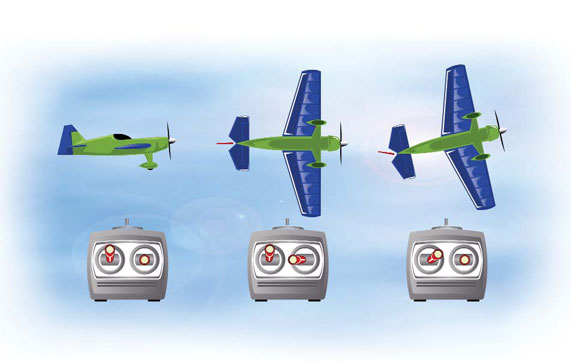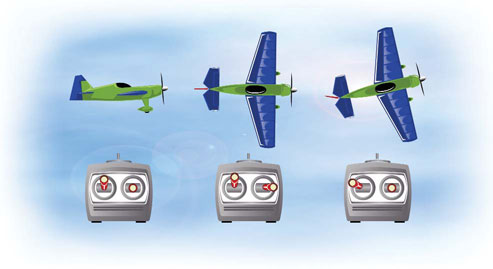|
With more and more folks chasing RTF and ARF park flyer aircraft, I increasingly hear guys at the field discussing various 3D maneuvers. I kept thinking of ways to help people understand the basics behind flying certain maneuvers. Most of these entail giving proper inputs while the plane changes its attitude in the air. While the majority of beginner sport pilots only have to contend with keeping aileron and rudder inputs straight as the plane is flying away from and coming towards them, when you start flying 3D, you have to keep track of the plane’s attitude and instinctively make your mind shift orientation with the plane. But this doesn’t have to be as daunting as it sounds. There are very simple ways to teach new pilots the basics of keeping track of which inputs you should give as the plane changes attitude. This month I will give an intro to the basics of knife-edge (KE) flight; if you practice this fairly simple maneuver, you’ll master the fundamentals quickly. Although I only discuss rolling your plane 90 degrees and adding rudder input to maintain level flight, you might save yourself some cash if you practice these moves on a simulator to teach your thumbs the proper movements before you transition to the airfield. One of the key things to remember when trying to learn 3D flight is that you really need to view the throttle channel as nothing more than another control surface. If you can get the notion out of your head that “throttle” means “speed,” you’ll progress much faster as you learn how to fly the various 3D maneuvers. |
 |
| Remember that if you move your aileron stick in, you’ll always follow by moving the rudder stick in as well. Don’t confuse yourself with left aileron, right rudder. |
 |
| The same basic stick movements apply when moving the right stick out; just remember to move the left stick out as well. To clean up the maneuver, feed in a little up-elevator. This will eliminate the coupling that will cause your plane to perform a KE circle. |
|
Let’s start by getting the aircraft in a nice, level flight attitude. Do this at an altitude that’s high enough to give yourself plenty of time to recover. If you make a mistake, e.g., incorrect rudder input, you need to be high enough to give yourself time to get back on top of the sticks before your plane hits the ground. Enough altitude to recover from a mistake is commonly referred to as “one mistake high.” Starting off two mistakes high is a good idea. The exercise you’ll be doing won’t be “natural” at first, but with a little practice (and an insanely easy memory tool), you’ll learn how to knife-edge in no time, and you’ll find yourself flying closer and closer to the ground. INS Bring your plane in front of you either from left to right or right to left. For illustration purposes, I’ll assume that you’re making a left-to-right pass. Depending on your aircraft, you’ll need to be at about 1/2 to 3/4 throttle. While flying level, give enough left aileron input to roll the plane 90 degrees. You should now be looking at the bottom of the plane as it passes by, and you’ll most likely notice that it will quickly lose altitude. Make a few passes, and practice rolling the plane 90 degrees by using left aileron input, and then return to level flight. When you’re comfortable with that, move to the next step adding rudder. OK; so you made a few passes, rolled the plane onto its side, watched it lose altitude and rolled it back to level right? Good. Now it’s time to add rudder to keep it flying level without losing altitude as it passes by. Normally, you would use the elevator to change your plane’s pitch: down-elevator causes the plane to descend and up-elevator causes the plane to climb. But when flying with the plane rotated at 90 degrees, the rudder, in effect, becomes the elevator and is the control surface you’ll use to maintain altitude. The trick is knowing in which direction to move the control sticks at any given time. This is where the “Ins and outs” (as I call them) of knife-edge come into play. When you rolled your plane 90 degrees with left aileron you moved the right stick of your transmitter towards the center. To maintain altitude with rudder, you’ll have to move the left stick in as well. That’s right: to fly knife-edge, your left stick should mimic the last input given by the right stick. Easy right? Now make a few more passes, and practice nothing more than maintaining altitude after you’ve rolled the plane onto its side with left aileron. Right stick moves in until the plane is on its side; then the left stick moves in to maintain altitude. As you practice. you’ll notice that you can start making rudder inputs earlier to make things smoother. OUTS As crazy as it may sound, rolling 90 degrees to the right with right aileron and flying knife-edge is handled in the same way as rolling left; just remember that the left stick mimics the last input given by the right stick. If the right stick moves out, your left stick will also move out. Practice this until you’re comfortable, and then move on to the next step. COUPLING Nearly all aircraft exhibit some sort of coupling. It will become evident when you attempt knife-edge flight, and you’ll find that your plane will naturally try to drift in the direction of the landing gear. To compensate for this, you’ll have to feed in slight up-elevator to maintain a straight flight path without yaw. If you have a computer radio, you can program a rudder-elevator mix to eliminate this coupling. CONCLUSION This isn’t an in-depth look at the technical aspects of knife-edge flight; it’s intended to give newcomers a no-nonsense look at the basics of flying knife-edge. With the simple “In and out” memory tool, it shouldn’t take very long to nail down the basics. Then you can play with transitioning into and out of KE and manipulating throttle and rudder input to fly KE at high angles of attack; and, when you’re feeling frisky, you can start cutting power and add a bit more rudder for a cool descending KE pass. Just don’t forget to add slight up-elevator to eliminate coupling. |
 Fly RC Magazine WE LIVE RC
Fly RC Magazine WE LIVE RC
